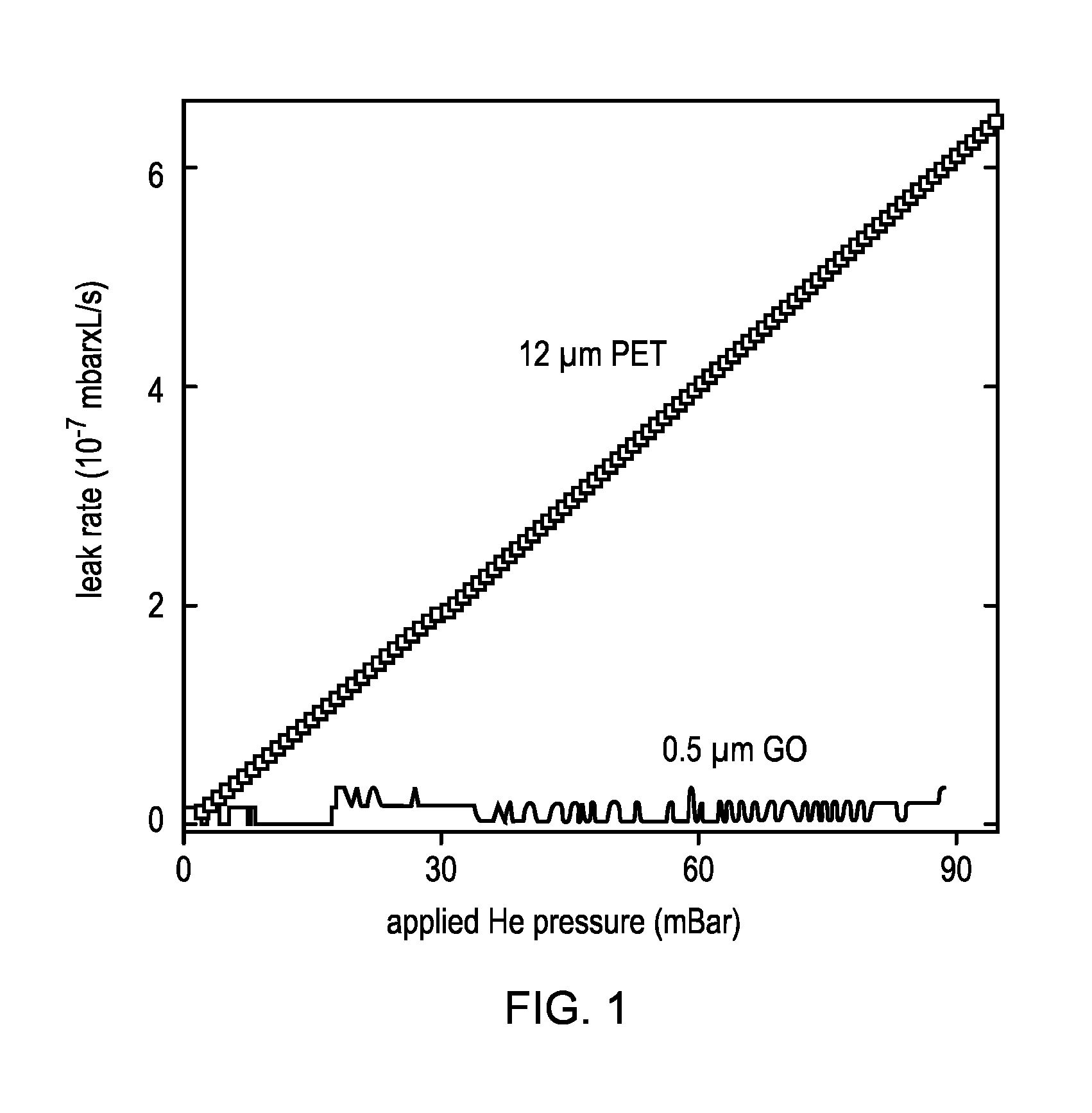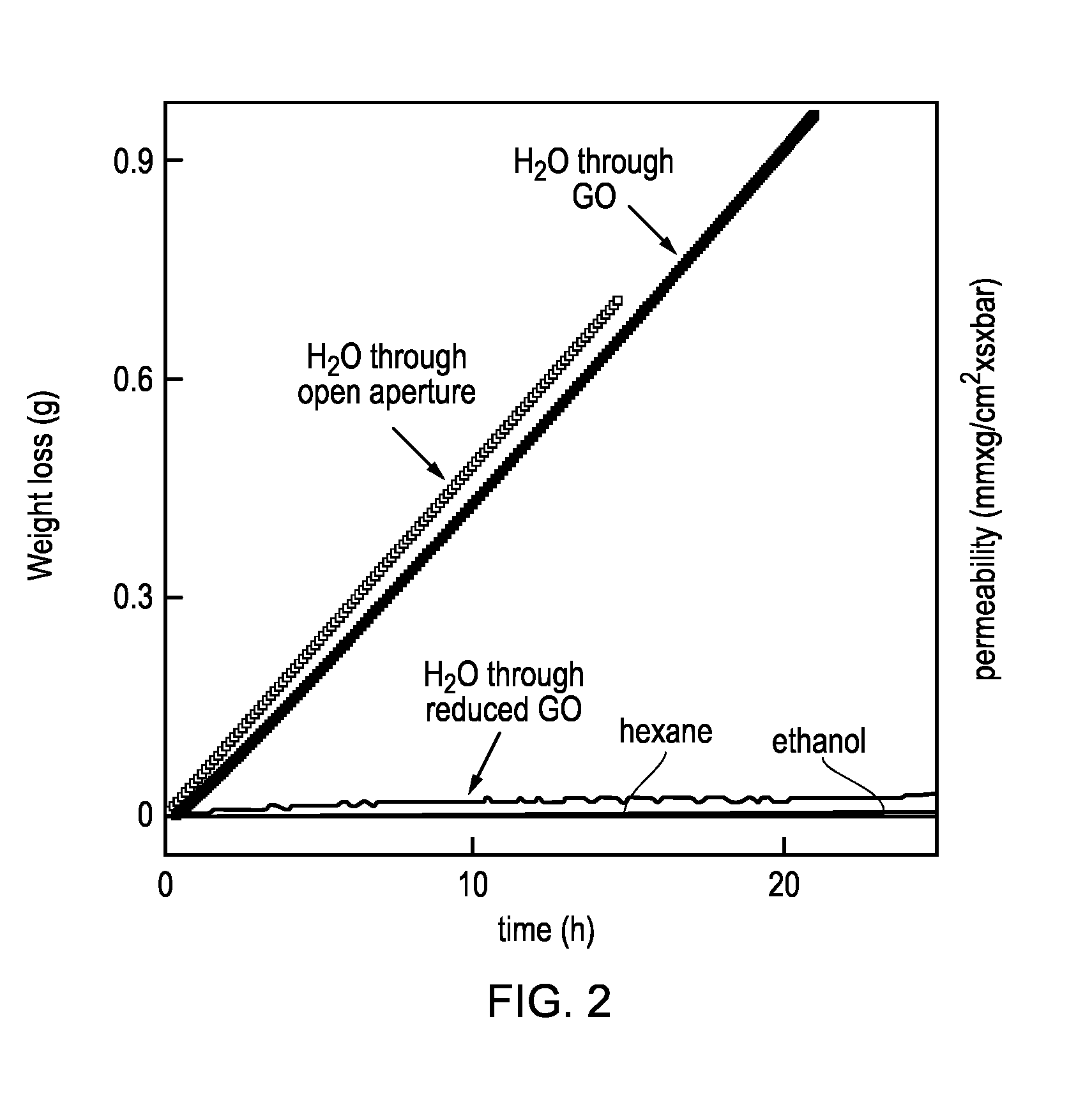Separation of Water Using a Membrane
- Summary
- Abstract
- Description
- Claims
- Application Information
AI Technical Summary
Benefits of technology
Problems solved by technology
Method used
Image
Examples
example 1
[0120]This example relates to the permeation properties of GO. The studied GO membranes were prepared as follows: We employed Hummer's method to obtain graphite oxide that was dispersed in water by sonication to make a stable suspension of GO crystallites. We then used this suspension to produce laminates by spray- or spin-coating. Scanning electron microscopy and x-ray analysis reveal that such GO films have a pronounced layered structure and consist of crystals with typical sizes L of a few micrometers, which are separated by a typical distance d of ˜10 {acute over (Å)}. For the Example 1 permeation experiments, Cu foils of several centimeters in diameter were uniformly covered with the GO laminates. Then, we chemically etched Cu to produce apertures of diameter D 1 cm fully covered by freestanding GO films. Finally, a metal container was sealed by using the Cu disks. We studied membranes with thicknesses h from 0.1 to 10 μm. Even submicrometer-thick membranes were strong enough t...
example 2
[0125]This example relates to the permeation properties of GO on a permeable membrane. A 500 nm thick GO layer supported on an Anopore membrane (20 mm diameter) was prepared by vacuum filtration of graphene oxide solution in water through the alumina membrane. The pore size of the Anopore alumina membrane was 200 nm. The permeability of water, ethanol and methanol through the membrane was determined by measuring the weight loss from a metal container sealed with the GO / membrane composite. A comparative experiment was also performed to determine the permeability of water through an Anopore membrane. The measurements were carried out at room temperature and zero humidity.
[0126]FIG. 3 shows the evaporation rates. As can be seen, the evaporation rate through the GO on Anopore composite and the reference Anopore membrane are practically the same. On the other hand the GO on Anopore composite is completely impermeable to the methanol and ethanol vapours.
example 3
[0127]This example shows 2-propanol permeation through supported GO membranes.
[0128]To enhance the mechanical stability of GO membranes, we have deposited graphene oxide on different polymer / ceramic porous support and studied their influence on the graphene oxide's membrane property. We have used anodisc alumina, Polytetrafluoroethylene (PTFE), Polyvinylidene fluoride (PVDF) and Cyclopore Polycarbonate (PC) support. We measured the vapour permeation of 2-propanol (2-propanol leak test) at room temperature and room humidity to study the influence of support membrane on property of graphene oxide membrane. Table 1 below shows the 2-propanol leak test performed for GO on different support membranes. The porosity of all the support membranes was identical and for each was 200 nm so that a direct comparison could be made. The table demonstrates that the support material has an effect on graphene oxides membrane properties. The best substrate found so far is the Anodisc alumina membrane. ...
PUM
| Property | Measurement | Unit |
|---|---|---|
| Thickness | aaaaa | aaaaa |
| Thickness | aaaaa | aaaaa |
| Thickness | aaaaa | aaaaa |
Abstract
Description
Claims
Application Information
 Login to View More
Login to View More - R&D
- Intellectual Property
- Life Sciences
- Materials
- Tech Scout
- Unparalleled Data Quality
- Higher Quality Content
- 60% Fewer Hallucinations
Browse by: Latest US Patents, China's latest patents, Technical Efficacy Thesaurus, Application Domain, Technology Topic, Popular Technical Reports.
© 2025 PatSnap. All rights reserved.Legal|Privacy policy|Modern Slavery Act Transparency Statement|Sitemap|About US| Contact US: help@patsnap.com



